[English] 日本語
 Yorodumi
Yorodumi- PDB-6yp7: PSII-LHCII C2S2 supercomplex from Pisum sativum grown in high lig... -
+ Open data
Open data
- Basic information
Basic information
| Entry | Database: PDB / ID: 6yp7 | ||||||||||||||||||||||||
|---|---|---|---|---|---|---|---|---|---|---|---|---|---|---|---|---|---|---|---|---|---|---|---|---|---|
| Title | PSII-LHCII C2S2 supercomplex from Pisum sativum grown in high light conditions | ||||||||||||||||||||||||
 Components Components |
| ||||||||||||||||||||||||
 Keywords Keywords | PHOTOSYNTHESIS / Cryo-EM / photosystem II / High Light | ||||||||||||||||||||||||
| Function / homology |  Function and homology information Function and homology informationphotosynthesis, light harvesting / photosystem II oxygen evolving complex / photosystem II assembly / oxygen evolving activity / photosystem II stabilization / photosystem II reaction center / photosystem II / oxidoreductase activity, acting on diphenols and related substances as donors, oxygen as acceptor / photosynthetic electron transport chain / photosystem I ...photosynthesis, light harvesting / photosystem II oxygen evolving complex / photosystem II assembly / oxygen evolving activity / photosystem II stabilization / photosystem II reaction center / photosystem II / oxidoreductase activity, acting on diphenols and related substances as donors, oxygen as acceptor / photosynthetic electron transport chain / photosystem I / photosystem II / response to herbicide / : / chlorophyll binding / photosynthetic electron transport in photosystem II / phosphate ion binding / photosynthesis, light reaction / chloroplast thylakoid membrane / photosynthesis / electron transfer activity / protein stabilization / iron ion binding / heme binding / metal ion binding Similarity search - Function | ||||||||||||||||||||||||
| Biological species |  Pisum sativum (garden pea) Pisum sativum (garden pea) | ||||||||||||||||||||||||
| Method | ELECTRON MICROSCOPY / single particle reconstruction / cryo EM / Resolution: 3.8 Å | ||||||||||||||||||||||||
 Authors Authors | Grinzato, A. / Albanese, P. / Zanotti, G. / Pagliano, C. | ||||||||||||||||||||||||
 Citation Citation |  Journal: Int J Mol Sci / Year: 2020 Journal: Int J Mol Sci / Year: 2020Title: High-Light versus Low-Light: Effects on Paired Photosystem II Supercomplex Structural Rearrangement in Pea Plants. Authors: Alessandro Grinzato / Pascal Albanese / Roberto Marotta / Paolo Swuec / Guido Saracco / Martino Bolognesi / Giuseppe Zanotti / Cristina Pagliano /  Abstract: In plant thylakoid membranes Photosystem II (PSII) associates with a variable number of antenna proteins (LHCII) to form different types of supercomplexes (PSII-LHCII), whose organization is ...In plant thylakoid membranes Photosystem II (PSII) associates with a variable number of antenna proteins (LHCII) to form different types of supercomplexes (PSII-LHCII), whose organization is dynamically adjusted in response to light cues, with the CS more abundant in high-light and the CSM in low-light. Paired PSII-LHCII supercomplexes interacting at their stromal surface from adjacent thylakoid membranes were previously suggested to mediate stacking. Here, we present the cryo-electron microscopy maps of paired CS and CSM supercomplexes isolated from pea plants grown in high-light and low-light, respectively. These maps show a different rotational offset between the two supercomplexes in the pair, responsible for modifying their reciprocal interaction and energetic connectivity. This evidence reveals a different way by which paired PSII-LHCII supercomplexes can mediate stacking at diverse irradiances. Electrostatic stromal interactions between LHCII trimers almost completely overlapping in the paired CS can be the main determinant by which PSII-LHCII supercomplexes mediate stacking in plants grown in high-light, whereas the mutual interaction of stromal N-terminal loops of two facing Lhcb4 subunits in the paired CSM can fulfil this task in plants grown in low-light. The high-light induced accumulation of the Lhcb4.3 protein in PSII-LHCII supercomplexes has been previously reported. Our cryo-electron microscopy map at 3.8 Å resolution of the CS supercomplex isolated from plants grown in high-light suggests the presence of the Lhcb4.3 protein revealing peculiar structural features of this high-light-specific antenna important for photoprotection. | ||||||||||||||||||||||||
| History |
|
- Structure visualization
Structure visualization
| Movie |
 Movie viewer Movie viewer |
|---|---|
| Structure viewer | Molecule:  Molmil Molmil Jmol/JSmol Jmol/JSmol |
- Downloads & links
Downloads & links
- Download
Download
| PDBx/mmCIF format |  6yp7.cif.gz 6yp7.cif.gz | 1.6 MB | Display |  PDBx/mmCIF format PDBx/mmCIF format |
|---|---|---|---|---|
| PDB format |  pdb6yp7.ent.gz pdb6yp7.ent.gz | 1.4 MB | Display |  PDB format PDB format |
| PDBx/mmJSON format |  6yp7.json.gz 6yp7.json.gz | Tree view |  PDBx/mmJSON format PDBx/mmJSON format | |
| Others |  Other downloads Other downloads |
-Validation report
| Summary document |  6yp7_validation.pdf.gz 6yp7_validation.pdf.gz | 18.8 MB | Display |  wwPDB validaton report wwPDB validaton report |
|---|---|---|---|---|
| Full document |  6yp7_full_validation.pdf.gz 6yp7_full_validation.pdf.gz | 20 MB | Display | |
| Data in XML |  6yp7_validation.xml.gz 6yp7_validation.xml.gz | 414.4 KB | Display | |
| Data in CIF |  6yp7_validation.cif.gz 6yp7_validation.cif.gz | 474.6 KB | Display | |
| Arichive directory |  https://data.pdbj.org/pub/pdb/validation_reports/yp/6yp7 https://data.pdbj.org/pub/pdb/validation_reports/yp/6yp7 ftp://data.pdbj.org/pub/pdb/validation_reports/yp/6yp7 ftp://data.pdbj.org/pub/pdb/validation_reports/yp/6yp7 | HTTPS FTP |
-Related structure data
| Related structure data |  10865MC M: map data used to model this data C: citing same article ( |
|---|---|
| Similar structure data |
- Links
Links
- Assembly
Assembly
| Deposited unit | 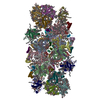
|
|---|---|
| 1 |
|
- Components
Components
-Protein , 2 types, 8 molecules gnyGNYoO
| #1: Protein | Mass: 23573.473 Da / Num. of mol.: 6 Source method: isolated from a genetically manipulated source Source: (gene. exp.)  Pisum sativum (garden pea) / Gene: CAB8, LHCB1 / Production host: Pisum sativum (garden pea) / Gene: CAB8, LHCB1 / Production host:  Pisum sativum (garden pea) / References: UniProt: P27490 Pisum sativum (garden pea) / References: UniProt: P27490#14: Protein | Mass: 26554.646 Da / Num. of mol.: 2 Source method: isolated from a genetically manipulated source Source: (gene. exp.)  Pisum sativum (garden pea) / Gene: PSBO / Production host: Pisum sativum (garden pea) / Gene: PSBO / Production host:  Pisum sativum (garden pea) / References: UniProt: P14226 Pisum sativum (garden pea) / References: UniProt: P14226 |
|---|
-Photosystem II ... , 13 types, 26 molecules aAbBcCdDhHiIjJkKlLmMtTwWzZ
| #2: Protein | Mass: 36972.074 Da / Num. of mol.: 2 Source method: isolated from a genetically manipulated source Source: (gene. exp.)  Pisum sativum (garden pea) / Gene: psbA, pgiI / Production host: Pisum sativum (garden pea) / Gene: psbA, pgiI / Production host:  Pisum sativum (garden pea) / References: UniProt: P06585, photosystem II Pisum sativum (garden pea) / References: UniProt: P06585, photosystem II#3: Protein | Mass: 55659.242 Da / Num. of mol.: 2 Source method: isolated from a genetically manipulated source Source: (gene. exp.)  Pisum sativum (garden pea) / Gene: psbB / Production host: Pisum sativum (garden pea) / Gene: psbB / Production host:  Pisum sativum (garden pea) / References: UniProt: Q9XQR6 Pisum sativum (garden pea) / References: UniProt: Q9XQR6#4: Protein | Mass: 49275.371 Da / Num. of mol.: 2 Source method: isolated from a genetically manipulated source Source: (gene. exp.)  Pisum sativum (garden pea) / Gene: psbC / Production host: Pisum sativum (garden pea) / Gene: psbC / Production host:  Pisum sativum (garden pea) / References: UniProt: P06004 Pisum sativum (garden pea) / References: UniProt: P06004#5: Protein | Mass: 38220.602 Da / Num. of mol.: 2 Source method: isolated from a genetically manipulated source Source: (gene. exp.)  Pisum sativum (garden pea) / Gene: psbD / Production host: Pisum sativum (garden pea) / Gene: psbD / Production host:  Pisum sativum (garden pea) / References: UniProt: P06006, photosystem II Pisum sativum (garden pea) / References: UniProt: P06006, photosystem II#8: Protein | Mass: 6455.607 Da / Num. of mol.: 2 Source method: isolated from a genetically manipulated source Source: (gene. exp.)  Pisum sativum (garden pea) / Gene: psbH / Production host: Pisum sativum (garden pea) / Gene: psbH / Production host:  Pisum sativum (garden pea) / References: UniProt: Q9XQR3 Pisum sativum (garden pea) / References: UniProt: Q9XQR3#9: Protein/peptide | Mass: 3926.691 Da / Num. of mol.: 2 Source method: isolated from a genetically manipulated source Source: (gene. exp.)  Pisum sativum (garden pea) / Gene: psbI / Production host: Pisum sativum (garden pea) / Gene: psbI / Production host:  Pisum sativum (garden pea) / References: UniProt: D5MAJ9 Pisum sativum (garden pea) / References: UniProt: D5MAJ9#10: Protein/peptide | Mass: 3598.264 Da / Num. of mol.: 2 Source method: isolated from a genetically manipulated source Source: (gene. exp.)  Pisum sativum (garden pea) / Gene: psbJ / Production host: Pisum sativum (garden pea) / Gene: psbJ / Production host:  Pisum sativum (garden pea) / References: UniProt: P13555 Pisum sativum (garden pea) / References: UniProt: P13555#11: Protein/peptide | Mass: 4287.155 Da / Num. of mol.: 2 Source method: isolated from a genetically manipulated source Source: (gene. exp.)  Pisum sativum (garden pea) / Gene: psbK / Production host: Pisum sativum (garden pea) / Gene: psbK / Production host:  Pisum sativum (garden pea) / References: UniProt: D5MAJ8 Pisum sativum (garden pea) / References: UniProt: D5MAJ8#12: Protein/peptide | Mass: 4366.904 Da / Num. of mol.: 2 Source method: isolated from a genetically manipulated source Source: (gene. exp.)  Pisum sativum (garden pea) / Gene: psbL / Production host: Pisum sativum (garden pea) / Gene: psbL / Production host:  Pisum sativum (garden pea) / References: UniProt: P60147 Pisum sativum (garden pea) / References: UniProt: P60147#13: Protein/peptide | Mass: 3641.425 Da / Num. of mol.: 2 Source method: isolated from a genetically manipulated source Source: (gene. exp.)  Pisum sativum (garden pea) / Gene: psbM / Production host: Pisum sativum (garden pea) / Gene: psbM / Production host:  Pisum sativum (garden pea) / References: UniProt: P69529 Pisum sativum (garden pea) / References: UniProt: P69529#15: Protein/peptide | Mass: 3692.472 Da / Num. of mol.: 2 Source method: isolated from a genetically manipulated source Source: (gene. exp.)  Pisum sativum (garden pea) / Gene: psbT / Production host: Pisum sativum (garden pea) / Gene: psbT / Production host:  Pisum sativum (garden pea) / References: UniProt: Q8HS25 Pisum sativum (garden pea) / References: UniProt: Q8HS25#16: Protein | Mass: 5914.629 Da / Num. of mol.: 2 Source method: isolated from a genetically manipulated source Source: (gene. exp.)  Pisum sativum (garden pea) / Production host: Pisum sativum (garden pea) / Production host:  Pisum sativum (garden pea) / References: UniProt: A0A2D0TCJ2 Pisum sativum (garden pea) / References: UniProt: A0A2D0TCJ2#18: Protein | Mass: 6555.742 Da / Num. of mol.: 2 Source method: isolated from a genetically manipulated source Source: (gene. exp.)  Pisum sativum (garden pea) / Gene: psbZ, ycf9 / Production host: Pisum sativum (garden pea) / Gene: psbZ, ycf9 / Production host:  Pisum sativum (garden pea) / References: UniProt: Q32902 Pisum sativum (garden pea) / References: UniProt: Q32902 |
|---|
-Cytochrome b559 subunit ... , 2 types, 4 molecules eEfF
| #6: Protein | Mass: 8624.707 Da / Num. of mol.: 2 Source method: isolated from a genetically manipulated source Source: (gene. exp.)  Pisum sativum (garden pea) / Gene: psbE / Production host: Pisum sativum (garden pea) / Gene: psbE / Production host:  Pisum sativum (garden pea) / References: UniProt: P13554 Pisum sativum (garden pea) / References: UniProt: P13554#7: Protein/peptide | Mass: 3396.035 Da / Num. of mol.: 2 Source method: isolated from a genetically manipulated source Source: (gene. exp.)  Pisum sativum (garden pea) / Gene: psbF / Production host: Pisum sativum (garden pea) / Gene: psbF / Production host:  Pisum sativum (garden pea) / References: UniProt: P62096 Pisum sativum (garden pea) / References: UniProt: P62096 |
|---|
-Light harvesting chlorophyll a/b-binding protein ... , 2 types, 4 molecules rRsS
| #19: Protein | Mass: 24460.893 Da / Num. of mol.: 2 Source method: isolated from a genetically manipulated source Source: (gene. exp.)  Pisum sativum (garden pea) / Production host: Pisum sativum (garden pea) / Production host:  Pisum sativum (garden pea) Pisum sativum (garden pea)#20: Protein | Mass: 23839.139 Da / Num. of mol.: 2 Source method: isolated from a genetically manipulated source Source: (gene. exp.)  Pisum sativum (garden pea) / Production host: Pisum sativum (garden pea) / Production host:  Pisum sativum (garden pea) / References: UniProt: A0A2D0TCJ1*PLUS Pisum sativum (garden pea) / References: UniProt: A0A2D0TCJ1*PLUS |
|---|
-Protein/peptide / Sugars , 2 types, 12 molecules xX

| #17: Protein/peptide | Mass: 3929.627 Da / Num. of mol.: 2 Source method: isolated from a genetically manipulated source Source: (gene. exp.)  Pisum sativum (garden pea) / Production host: Pisum sativum (garden pea) / Production host:  Pisum sativum (garden pea) / References: UniProt: Q8VYY1 Pisum sativum (garden pea) / References: UniProt: Q8VYY1#35: Sugar | ChemComp-DGD / |
|---|
-Non-polymers , 16 types, 315 molecules 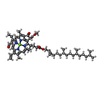

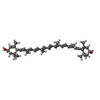
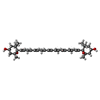
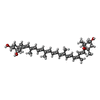

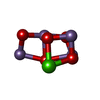




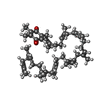

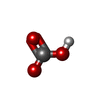

















| #21: Chemical | ChemComp-CHL / #22: Chemical | ChemComp-CLA / #23: Chemical | ChemComp-LUT / ( #24: Chemical | ChemComp-XAT / ( #25: Chemical | ChemComp-NEX / ( #26: Chemical | ChemComp-LHG / #27: Chemical | #28: Chemical | #29: Chemical | ChemComp-CL / #30: Chemical | ChemComp-PHO / #31: Chemical | ChemComp-BCR / #32: Chemical | ChemComp-PL9 / #33: Chemical | ChemComp-SQD / #34: Chemical | #36: Chemical | ChemComp-LMG / #37: Chemical | |
|---|
-Details
| Has ligand of interest | N |
|---|---|
| Has protein modification | N |
-Experimental details
-Experiment
| Experiment | Method: ELECTRON MICROSCOPY |
|---|---|
| EM experiment | Aggregation state: PARTICLE / 3D reconstruction method: single particle reconstruction |
- Sample preparation
Sample preparation
| Component | Name: PSII-LHCII C2S2 supercomplex / Type: COMPLEX / Entity ID: #1-#20 / Source: NATURAL |
|---|---|
| Source (natural) | Organism:  Pisum sativum (garden pea) Pisum sativum (garden pea) |
| Buffer solution | pH: 7 |
| Specimen | Embedding applied: NO / Shadowing applied: NO / Staining applied: NO / Vitrification applied: YES |
| Vitrification | Cryogen name: ETHANE |
- Electron microscopy imaging
Electron microscopy imaging
| Experimental equipment |  Model: Titan Krios / Image courtesy: FEI Company | ||||||||||||
|---|---|---|---|---|---|---|---|---|---|---|---|---|---|
| Microscopy | Model: FEI TITAN KRIOS | ||||||||||||
| Electron gun | Electron source:  FIELD EMISSION GUN / Accelerating voltage: 300 kV / Illumination mode: FLOOD BEAM FIELD EMISSION GUN / Accelerating voltage: 300 kV / Illumination mode: FLOOD BEAM | ||||||||||||
| Electron lens | Mode: BRIGHT FIELD | ||||||||||||
| Image recording |
|
- Processing
Processing
| Software | Name: PHENIX / Version: 1.15.2_3472: / Classification: refinement | ||||||||||||||||||||||||
|---|---|---|---|---|---|---|---|---|---|---|---|---|---|---|---|---|---|---|---|---|---|---|---|---|---|
| EM software | Name: PHENIX / Category: model refinement | ||||||||||||||||||||||||
| CTF correction | Type: NONE | ||||||||||||||||||||||||
| Symmetry | Point symmetry: C2 (2 fold cyclic) | ||||||||||||||||||||||||
| 3D reconstruction | Resolution: 3.8 Å / Resolution method: FSC 0.143 CUT-OFF / Num. of particles: 27942 / Symmetry type: POINT | ||||||||||||||||||||||||
| Refine LS restraints |
|
 Movie
Movie Controller
Controller








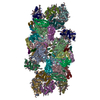


 PDBj
PDBj


























